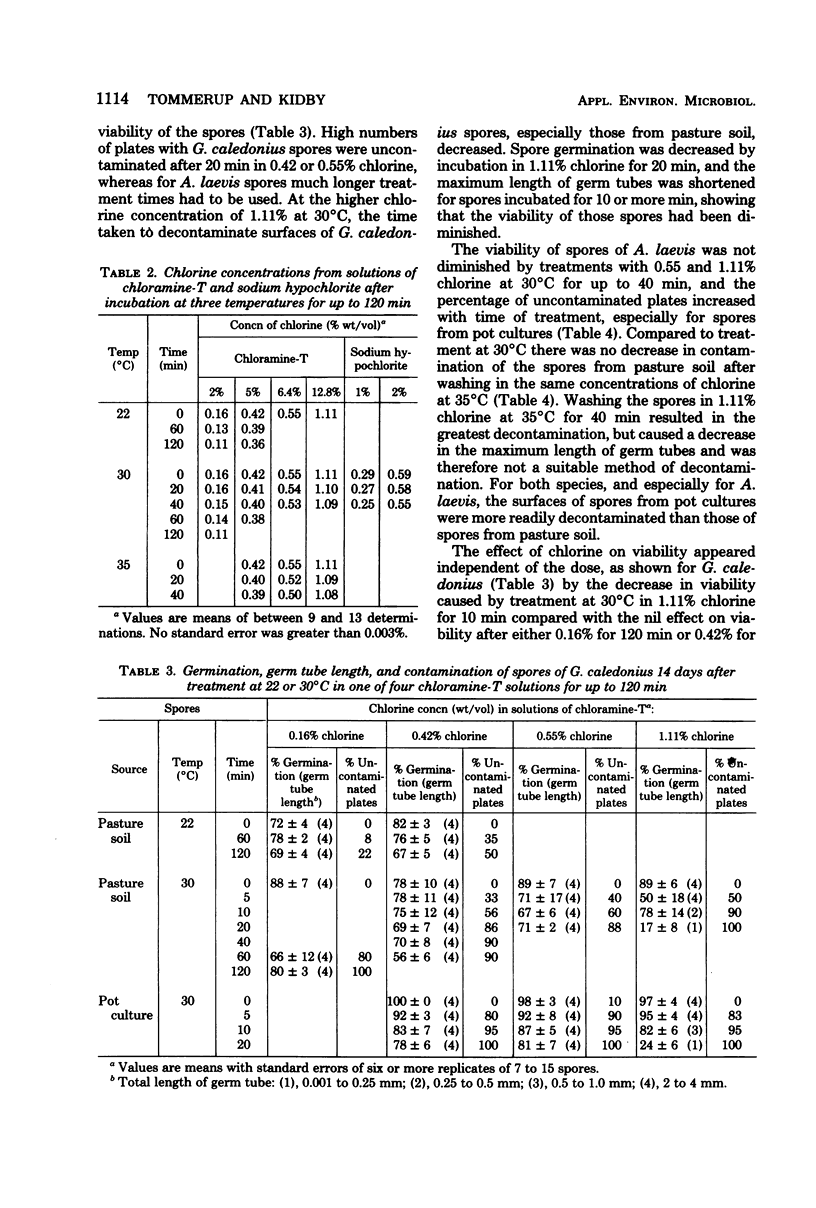Abstract
The survival of germinating spores of vesicular-arbuscular endophytes after treatments with oxidizing agents, antibiotics, moist heat, ultrasonic radiation, and ultraviolet radiation was compared with that of their contaminating microbes. Spores of three species were rapidly decontaminated by treatment with 0.42% (wt/vol) chlorine available from 5.0% (wt/vol) chloramine-T at 30°C for 20 to 40 min depending on the species and the soil from which they were extracted. This treatment did not change spore viability. The survival of spores was reduced by exposure for 20 min to 1.11% chlorine at 30°C for Glomus caledonius or at 35°C for Acaulospora laevis. Growth of any bacteria surviving treatment with oxidizing agents was inhibited by 100 μg of chloramphenicol per ml in agar; however, spore germination and germ tube growth were reduced only by concentrations greater than 200 μg/ml in agar. Spore germination was decreased by concentration of pimaracin, which controlled fungal growth. The spores survived moist heat at 40°C for 80 min, 55°C for 10 min, and 60°C for less than 1 min. The viability of spores was unaffected by ultrasonic irradiation for up to 4 min. Spores of G. caledonius and A. laevis were extremely resistant to ultraviolet radiation. Their viability was unaffected by exposure to 5 × 108 ergs cm−2 from an ultraviolet source of 253.7nm. The spores had very thick, pigmented walls, and the possibility that these provided some protection against the physical and chemical treatments is discussed. The degree of physiological damage to the spores caused by the treatments demonstrated some adverse effects of basic laboratory procedures. This information, together with that on the comparative sensitivity of contaminating microbes to the treatments, was used in the development of protocol for producing large numbers of uncontaminated spores.
Full text
PDF








Selected References
These references are in PubMed. This may not be the complete list of references from this article.
- Allwood M. C., Russell A. D. Mechanisms of thermal injury in nonsporulating bacteria. Adv Appl Microbiol. 1970;12:89–119. doi: 10.1016/s0065-2164(08)70583-5. [DOI] [PubMed] [Google Scholar]
- Bridges B. A., Ashwood-Smith M. J., Munson R. J. Correlation of bacterial sensitivities to ionizing radiation and mild heating. J Gen Microbiol. 1969 Sep;58(1):115–124. doi: 10.1099/00221287-58-1-115. [DOI] [PubMed] [Google Scholar]
- MOSSE B. The establishment of vesicular-arbuscular mycorrhiza under aseptic conditions. J Gen Microbiol. 1962 Mar;27:509–520. doi: 10.1099/00221287-27-3-509. [DOI] [PubMed] [Google Scholar]
- Moseley B. E., Williams E. Repair of damage; DNA in bacteria. Adv Microb Physiol. 1977;16:99–156. doi: 10.1016/s0065-2911(08)60048-x. [DOI] [PubMed] [Google Scholar]
- SETLOW J. K., DUGGAN D. E. THE RESISTANCE OF MICROCOCCUS RADIODURANS TO ULTRAVIOLET RADIATION. I. ULTRAVIOLET-INDUCED LESIONS IN THE CELL'S DNA. Biochim Biophys Acta. 1964 Aug 12;87:664–668. doi: 10.1016/0926-6550(64)90284-1. [DOI] [PubMed] [Google Scholar]
- Schenck N. C., Graham S. O., Green N. E. Temperature and light effect on contamination and spore germination of vesicular-arbuscular mycorrhizal fungi. Mycologia. 1975 Nov-Dec;67(6):1189–1192. [PubMed] [Google Scholar]
- Tinker P. B. Effects of vesicular-arbuscular mycorrhizas on higher plants. Symp Soc Exp Biol. 1975;(29):325–349. [PubMed] [Google Scholar]
- Tommerup I. C., Kidby D. K. Preservation of spores of vesicular-arbuscular endophytes by L-drying. Appl Environ Microbiol. 1979 May;37(5):831–835. doi: 10.1128/aem.37.5.831-835.1979. [DOI] [PMC free article] [PubMed] [Google Scholar]


